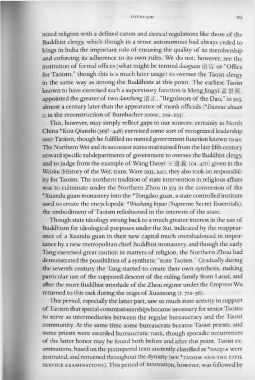Page 203 - The Encyclopedia of Taoism v1_A-L
P. 203
OV ERVIEW
nized religion with a defined canon and clerical regulations like those of the
Buddhist clergy, which though in a sense autonomous had always ceded to
kings in India the important role of ensuring the quality of its membership
and enforcing its adherence to its own rules. We do not, however, see the
institution of formal offices (what might be termed daoguan J]! '§ or "Office
for Taoism," though this is a much later usage) to oversee the Taoist clergy
in the same way as among the Buddhists at this point. The earliest Taoist
'known to have exercised such a supervisory function is MengJingyi :rih~W ,
appointed the greater of two daozheng J]!.lE , "Regulators of the Dao," in 503,
almost a century later than the appearance of monk officials (*Daoxue zhuan
7, in the reconstruction of Bumbacher 2000C, 219-223).
This, however, may simply reflect gaps in our sources: certainly in North
China *Kou Qianzhi (365?-448) exercised some sort of recognized leadership
over Taoism, though he fulfilled no named government function known to us.
The Northern Wei and its successor states maintained from the late fifth century
onward specific subdepartments of government to oversee the Buddhist clergy,
and to judge from the example of Wang Daoyi ::E J]! ~ (ca. 470) given in the
Weishu (History of the Wei; trans. Ware 1933, 241), they also took on responsibil-
ity for Taoists. The northern tradition of state intervention in religious affairs
was to culminate under the Northern Zhou in 574 in the conversion of the
*Xuandu guan monastery into the *Tongdao guan, a state controlled institute
used to create the encyclopedic *Wushang biyao (Supreme Secret Essentials),
the embodiment of Taoism refashioned in the interests of the state.
Though state ideology swung back to a much greater interest in the use of
Buddhism for ideological purposes under the Sui, indicated by the reappear-
ance of a Xuandu guan in their new capital much overshadowed in impor-
tance by a new metropolitan chief Buddhist monastery, and though the early
Tang exercised great caution in matters of religion, the Northern Zhou had
demonstrated the possibilities of a synthetic "state Taoism." Gradually during
the seventh century the Tang started to create their own synthesis, making
particular use of the supposed descent of the ruling family from Laozi, and
after the more Buddhist interlude of the Zhou regime under the Empress Wu
returned to this task during the reign of Xuanzong (r, 712- 56).
This period, especially the latter part, saw so much state activity in support
of Taoism that special commissionerships became necessary for senior Taoists
to serve as intermediaries between the regular bureaucracy and the Taoist
community. At the same time some bureaucrats became Taoist priests, and
some priests were awarded bureaucratic rank, though sporadic occurrences
of the latter honor may be found both before and after this point. Taoist ex-
aminations, based on the preimperial texts anciently classified as *DAO]IA were
instituted, and remained throughout the dynasty (see *TAOISM AND THE CIVIL
SERVICE EXAMINATIONS). This period of innovation, however, was followed by

